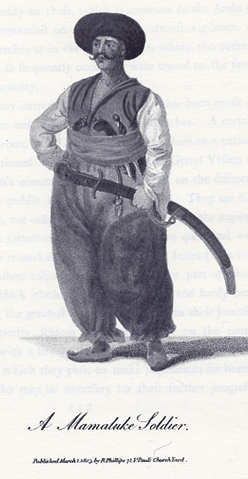
[Note: The following account is by the English traveler William Wittman, who commented on the foods and crops he saw while passing through the Levant in what was then Syria. The spelling is that of the original, from a time when proof reading was a distant concern and spelling was a democratic venture. The picture above is from the original 1803 edition.
Wherever the land is susceptible of cultivation, and has not been neglected, it affords abundant crops of wheat, barley, Indian corn (dourra), tobacco, cotton, and other productions. Fruits and vegetables are in equal abundance. Among the former are pomegranates, figs, oranges, lemons, citrons of an uncommonly large size, melons, grapes, and olives. The melons are large, and have a delicious flavour; as have also the grapes. of which we partook so late as the month of December, when we found they still retained their exquisite flavour. I have already adverted to the uncommon size of the water-melons, many of which weight from twenty to thirty pounds. they are a great and valuable resource to the inhabitants, who are so passionately fond of them, that, during the summer months, they form a great part of their subsistence. Notwithstanding they are as cooling and refreshing, as grateful to the taste, I was surprised to see the natives eat them in such immoderate quantities, without experiencing any unpleasant consequences.
Among the vegetable productions for the table may be ranged the coulcas, the okre, or bannier, the coussa, a species of gourd, the tomata, and a kind of bean which has resemblance to our French bean. The coulcas is a root brought from Bairout, Acre, Sidon, and Damietta, which, when cooked,is in taste not unlike the potatoe, from which it differs in appearance by its darker hue and less regular shape. In its raw state it is extremely acrid, and produces on the mouth and fauces, when tasted, a sensation of pricking and smarting, such as is caused, under the same circumstances, by the Arum root. It is considered by the inhabitants as a wholesome and agreeable vegetable, and, being scraped and boiled, enters into the composition of many of their dishes. the okre is a fine mucilaginous vegetable, which gives an excellent flavour to the soups.
To the above list may be added other vegetables, the quality of which is excellent, such as cabbages, cauliflowers, spinage, lettuce, endive, turnips, cucumbers, radishes, and onions; the latter extremely mild. Both fruits and vegetables, as well as all other marketable commodities, are sold by weight.
The grounds in Syria are in general open. Where enclosures have been attempted, they are fenced in with the prickly pear tree.
Numerous flocks of goats and sheep are distributed over the plains, as well as in the mountainous territory. The tails of the latter are uncommonly large, resembling those of sheep of the Cape of Good Hope. Many of them have an extraordinary length of ear; but this observation applies still more particularly to the goats, an ear of one of which I had the curiosity to measure, and found it to be nine inches in length. the cows and oxen are small, and of a reddish hue: large herds of them are driven out in the mornings, to browse in the plains, and in those parts of the mountainous territory, where a scanty superficies of soil, spread over the rocks, affords a feeble hope of pasturage.
The animal food of the Syrians consists principally of mutton and goat’s flesh, and they consume but a very small proportion of beef, and no veal. They are, indeed, very sparing in their use of flesh, chiefly confining themselves in their diet to the vegetable productions they have in such great abundance, and of such excellent quality…
The inhabitants of Syria are very abstemious in their diet, which is simple in the extreme. It consists chiefly of salted olives, cheese of a poor and indigestible quality, a coarse bread badly baked, and formed into flat cakes, and rancid butter, or perhaps oil. They rarely indulge themselves in the use of animal food; but on these occasions prepare a wholesome, and to many a palatable dish called pilaw, by stewing the flesh with the rice. Notwithstanding their common beverage is water, a spiritous compound, called racky, made from the fermented husks and stalks of grapes, distilled with aniseeds, is imported into Syria from Turkey and Asia.
Excerpt from William Wittman, Travels in Turkey, Asia Minor, Syria and Egypt. London: Richard Phillips, 1803, pp. 213-215, 217.
[Tabsir Redux is a reposting of earlier posts on the blog, since memories are fickle and some things deserve a second viewing. This post was originally made on August 24, 2009.]